论马来西亚语言特点
马来西亚语 翻译
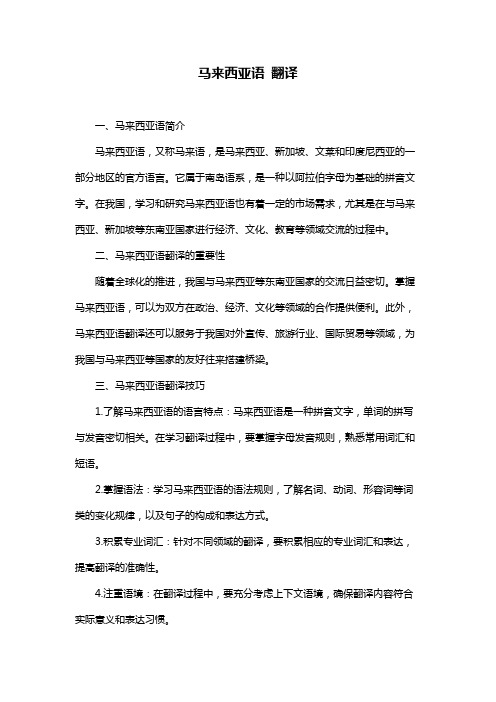
马来西亚语翻译一、马来西亚语简介马来西亚语,又称马来语,是马来西亚、新加坡、文莱和印度尼西亚的一部分地区的官方语言。
它属于南岛语系,是一种以阿拉伯字母为基础的拼音文字。
在我国,学习和研究马来西亚语也有着一定的市场需求,尤其是在与马来西亚、新加坡等东南亚国家进行经济、文化、教育等领域交流的过程中。
二、马来西亚语翻译的重要性随着全球化的推进,我国与马来西亚等东南亚国家的交流日益密切。
掌握马来西亚语,可以为双方在政治、经济、文化等领域的合作提供便利。
此外,马来西亚语翻译还可以服务于我国对外宣传、旅游行业、国际贸易等领域,为我国与马来西亚等国家的友好往来搭建桥梁。
三、马来西亚语翻译技巧1.了解马来西亚语的语言特点:马来西亚语是一种拼音文字,单词的拼写与发音密切相关。
在学习翻译过程中,要掌握字母发音规则,熟悉常用词汇和短语。
2.掌握语法:学习马来西亚语的语法规则,了解名词、动词、形容词等词类的变化规律,以及句子的构成和表达方式。
3.积累专业词汇:针对不同领域的翻译,要积累相应的专业词汇和表达,提高翻译的准确性。
4.注重语境:在翻译过程中,要充分考虑上下文语境,确保翻译内容符合实际意义和表达习惯。
四、马来西亚语翻译实践与应用1.文学作品翻译:将我国文学作品翻译成马来西亚语,有助于传播中国文化,增进两国人民的友谊。
2.商务洽谈翻译:在商务活动中,为双方提供马来西亚语翻译服务,促进商务合作的顺利进行。
3.旅游导览翻译:为游客提供马来西亚语导游服务,让他们更好地了解和融入当地文化。
4.影视作品翻译:将我国的影视作品翻译成马来西亚语,扩大我国影视作品在海外市场的影响力。
五、提高马来西亚语翻译水平的建议1.学习马来语基础知识:掌握字母发音规则、语法、常用词汇和短语等。
2.多练习翻译:通过翻译实践,不断提高自己的翻译水平和应对各种翻译场景的能力。
3.参加马来语培训课程:报名参加马来语培训课程,系统地学习马来语知识。
4.与马来语母语者交流:多与马来语母语者交流,了解他们的语言习惯和文化背景。
马来西亚英语口头禅
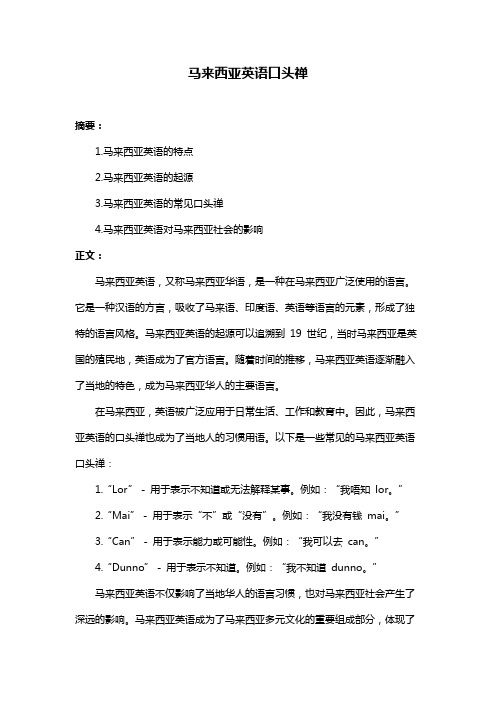
马来西亚英语口头禅
摘要:
1.马来西亚英语的特点
2.马来西亚英语的起源
3.马来西亚英语的常见口头禅
4.马来西亚英语对马来西亚社会的影响
正文:
马来西亚英语,又称马来西亚华语,是一种在马来西亚广泛使用的语言。
它是一种汉语的方言,吸收了马来语、印度语、英语等语言的元素,形成了独特的语言风格。
马来西亚英语的起源可以追溯到19 世纪,当时马来西亚是英国的殖民地,英语成为了官方语言。
随着时间的推移,马来西亚英语逐渐融入了当地的特色,成为马来西亚华人的主要语言。
在马来西亚,英语被广泛应用于日常生活、工作和教育中。
因此,马来西亚英语的口头禅也成为了当地人的习惯用语。
以下是一些常见的马来西亚英语口头禅:
1.“Lor” - 用于表示不知道或无法解释某事。
例如:“我唔知lor。
”
2.“Mai” - 用于表示“不”或“没有”。
例如:“我没有钱mai。
”
3.“Can” - 用于表示能力或可能性。
例如:“我可以去can。
”
4.“Dunno” - 用于表示不知道。
例如:“我不知道dunno。
”
马来西亚英语不仅影响了当地华人的语言习惯,也对马来西亚社会产生了深远的影响。
马来西亚英语成为了马来西亚多元文化的重要组成部分,体现了
马来西亚人民的包容性和创新精神。
同时,马来西亚英语也为马来西亚的经济发展做出了贡献,吸引了大量外国投资和旅游业的发展。
总之,马来西亚英语是一种充满活力和特色的语言,它既保留了汉语的传统,又吸收了其他语言的元素。
马来西亚英语的特征分析
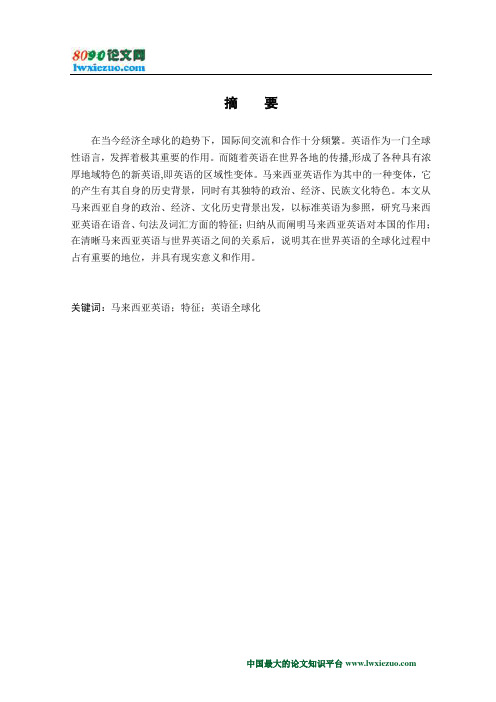
摘要在当今经济全球化的趋势下,国际间交流和合作十分频繁。
英语作为一门全球性语言,发挥着极其重要的作用。
而随着英语在世界各地的传播,形成了各种具有浓厚地域特色的新英语,即英语的区域性变体。
马来西亚英语作为其中的一种变体,它的产生有其自身的历史背景,同时有其独特的政治、经济、民族文化特色。
本文从马来西亚自身的政治、经济、文化历史背景出发,以标准英语为参照,研究马来西亚英语在语音、句法及词汇方面的特征;归纳从而阐明马来西亚英语对本国的作用;在清晰马来西亚英语与世界英语之间的关系后,说明其在世界英语的全球化过程中占有重要的地位,并具有现实意义和作用。
关键词:马来西亚英语;特征;英语全球化ABSTRACTIn the current trend of economic globalization, there are frequent international exchanges and cooperation between nations. As a global language, English plays an extremely important role. With the spread of English around the world, it has formed many different Englishes of strong geographic features, that is, varieties of English. Malaysian English is one of the varieties, which has its own historical background of causes, and has its own unique political, economic, and culture characteristics. This paper will research the differences between Standard English and Malaysian English on the sound, syntax and the vocabulary from Malaysia's own political, economic, cultural and historical background; clarify the role of English on their own country; after clearing the relationship between Malaysian English and World English, illustrates Malaysian English has a place in the promotion of the globalization of English and has practical significance and function.Keywords:Malaysian English; characteristics; English globalizationContents1.Introduction (5)2. Background of Malaysian English (6)2.1 The History of Malaysian English (6)2.2 The Influencing Factors on Malaysian English (7)2.2.1 The Economical Factor (7)2.2.2 The Ethnic Cultural Factor (7)2.2.3 The Education and Language Policy Factor (8)3. The Characteristics of Malaysian English (10)3.1 Pronunciation (10)3.1.1 Final Consonants (10)3.1.2 V owels (11)3.2 Syntax (12)3.2.1 Features Connected with the Verb (12)3.2.2 The Noun Phrase (12)3.2.3 Lexical Items (13)3.3 V ocabulary (14)3.3.1 The “Lah” Word (14)3.3.2 The other Words of Malaysian English (15)4. The Status and Influence of Malaysian English (16)Acknowledgements (20)References (21)1.IntroductionWith the development of economic globalization, English has become one of the most important and useful language in the world, and we should not ignore the importance of it.In this global context, English is widely used in different country and some countries have formed its unique English with its local color. Malaysian English is one of established world Englishes and shows its significant role in the globalization of English language. But the study at home or abroad still hasn‟t done much rearch on it, therefore, My degree paper makes an analysis of Malaysia English with an aim of promoting understand of varieties of English. The paper consists of three parts. The first one is about the background of the Malaysian English, and the influence factors on ME. The second part is to compare the differences between Standard English and Malaysian English on the pronunciation, syntax and vocabulary, and get the characteristics of Malaysian English. The third is to sum up the influence and functions of Malaysian English the hope of offering the readers a correct attitude towards the globalizaition of English.2. Background of Malaysian EnglishIn theory, English as spoken in Malaysia called Malaysian English (ME) and is based on British English. Malaysian English generally followed British spelling, but it influenced by American English (AE), for instance, the expression and slang of American English is strong, especially among Malaysian youth. While Malaysian English is strongly influenced by Mandarin, Cantonese, Hokkien and Tamil, which are other major dialects and languages spoken in Malaysia.2.1 The History of Malaysian EnglishMalaysia is a multinational country with about thirty ethic groups. So Malaysian government acknowledges this multilingualism through such things as television news broadcasts in Malay, English, Mandarin, and Tamil.Among many languages, Malay is its official language and English is a widely-used language due to the history of Malayisa and the importance of English language itself.Malaysia once was colonized by Britain in the late nineteenth and early twentieth century. The British wanted spread English languge in its colonies in order to serve Britain‟s strategic and commercial interests. After its independence in 1957, the Federation of Malaya retained English as one of two official languages, along with the major indigenous language, Malay, which was also selected as the sole national language. English continued to serve as the dominant language of education, government and law, and large-scale banking and commerce (Le Page, 1962). The second half of the 1960s brought implementation of a policy to increase the use of Malay in the expanded nation of Malaysia. In 1969 the Ministry of Education initiated a policy whereby all English-medium schools were to become Malay-medium. By 1983 this process had been completed nationwide at the primary through tertiary levels of education. [11] One result of this language policy has been a dramatic increase in Malaysians‟ use of Malay, renamed Bahasa Malaysia, and a corresponding decrease in their use of English, particularly outside the cities (Lowenberg, 1988). However, such mind of the decline in English proficiency among Malaysians overlook the fact that English is still widely used by the current Malaysian elites, who were educated in English-medium schools during the colonial or initial postcolonial periods and are still quite proficient in English. They still set the standards for English usage as leading journalists for the most prestigiousEnglish-language newspapers, and as writers and editors of the government-authorized English language textbooks (Lowenberg, 1991).2.2 The Influencing Factors on Malaysian EnglishMalaysian English as a variety of world Englishes, it has been affected by various factors and has formed its unique characteristics which differ from British English and other Englishes in the world.2.2.1 The Economical FactorBusiness in the company field is dealt with more in English than in Malay, in both local and multinational concerns. Banks and insurance companies use only English. Only recently have banks come to use bilingual Malay-English texts in their prospectus. Agreements, contracts, policies, and regulations are still in English.The importance of English is also seen in making Malaysia an industrial country. Until a few years ago Malaysia was basically an exporter of agricultural products, e.g. palm oil, rubber, timber, cocoa, etc. In the 1970s an intensive program for the diversification of industry was implemented, and Malaysia has now evolved into an exporter of manufactured goods. In 1993, 71 per cent of Malaysia‟s exports comprised such goods, the bulk of which were electrical and electronic goods. [5]Business and industry is traditionally a non-Malay area. It has been dominated by the Chinese and the Europeans. The was only in the 1970s that the Malays started to venture into big business, gaining access through government assistance with the implementation of the New Economic Policy (1970), which has sought to ensure that there is at least 30 per cent participation by the indigenous people in business and industry. Pragmatism has made Malay-owned companies retain English as the main, if not the sole, language of communication. This is because they have to join the mainstream business and industry in the country as well as participate in international networks in order to succeed. (Asmah Haji Omar, 1996)2.2.2 The Ethnic Cultural FactorThere are twenty-three million people in Malaysia‟s population, 60 per cent are classified as Malay, 25 per cent as of Chinese descent, 10 per cent of Indian descent, and5 per cent as others.Malaysia's ethnic diversity is both a blessing and a source of stress. The melange makes Malaysia one of the most cosmopolitan places on earth, as it helps sustain international relationships with the many societies represented in Malaysia: the Indonesian archipelago, the Islamic world, India, China, and Europe. Malaysians easily exchange ideas and techniques with the rest of the world, and have an influence in global affairs. The same diversity presents seemingly intractable problems of social cohesion, and the threat of ethnic violence adds considerable tension to Malaysian politics. (/Ja-Ma/Malaysia.html)On the whole, there had been significant increases in the ability to speak English among the various groups in the decade 1970-80. The rise in the per cent ages was due to the second language status given English by the New Education Policy. Based on the rigor which had gone into 1980s, it can be predicted that the increase in the number of speakers of English since 1980 should be as significant, if not more so than the increase between 1970 and 1980.There has hardly been any research on the attitude of Malaysians toward the use of English in social communication. Asmah Haji Omar‟s research on language choice among 45 Malaysian academics shows that English is the main language in their day-to-day communication with family members and friends and in the pursuit of entertainment and hobbies. (Asmah Haji Omar, Post-imperial English in Malaysia) English and Malay are educational languages in schools. The latter language is used only in interaction with those who do not know English or in work places where Malay is the official language.So that English comes more readily to them when want to communicate compared to Malay or their own mother tongues. This could have been due to their school background from the colonial and post-Independence days when English was the medium of education in the English schools.2.2.3 The Education and Language Policy FactorSince the British colonial status of the nineteenth and twentieth century came an ever-increasing demand for English in Malaysia. English-medium schools were established, beginning early in the nineteenth century in the Straits Settlement but gradually spreading to the Malay states as well. The goal of these institutions was strictly utilitarian, serving the interests of the British: to train local elite for administrative andservice functions. Essentially, formal access to English was a privilege to those of higher status amongst the indigenous population. Education at the institutions was served for the nobility and the rich implied complete immersion into English. This educational policy had long-lasting effects that went beyond what the British had had in mind: English-medium education in this interethnic bonds and established a value system that soon thereafter paved the way to a desire for independence. [6]With the constitution of 1957, the role of English began being curtailed. English was retained as a co-official language in addition to Malay, but the pronounced intention was to develop Malay into a national language and to remove this special status of English after a ten-year transition period. Due to regional differences caused by the union with part of Borneo this period was somewhat extended: the official status of English ceased in peninsular Malaysia in 1967. Formally, “National Language Act of 1967 disestablished English as the joint official language, giving sole status to Malay”. (Edgar Werner Schneider, 2007)The national Language Acts of 1963 and 1967 and a consolidation act of 1971 modified this somewhat. Thus, all proceedings in the court were to be in the national language or English or partly in one and partly in the other. Thus it can be seen that English was retained for some time for the courts and parliament. Languages of education has also been generally true in Malaysia, although it would not be appropriate to consider the policy of allowing primary education in Mandarin or Tamil, with Bahasa Malaysia as second language as merely …expediency‟.At present, the policy of implementing Bahasa Malaysia as the national language, there has obviously been a change in the relative statuses of Bahasa Malaysia and English. For the Malays, there is obviously a sentimental attachment to Bahasa Malaysia. Many of those now able to receive higher education and higher status positions are not from a background in which English had any great relevance. For the rural population, there would have been a degree of awareness that English was the language of the British administration and a language of power but as they had little or no opportunity to learn it they had neither sentimental nor instrumental attachment to it.For some English-medium educated Malaysians, English has been on the borderline of being a Second Language and a First Language, but the number of such people will diminish. For many, especially those who do not go on to higher education and have little or no contact with the English-speaking would, English, although it is taught as a …second language‟ will be more a …foreign language‟.3. The Characteristics of Malaysian EnglishMalaysian English can be divided into two: ①Malaysian English I can be standard ME—with the exception of a minority of Malaysian speakers who have been educated abroad and have achieved near-native speaker proficiency generally speaking. ②Malaysian English II can be sub-standard ME or local dialect—it has all the features of the first variety of Malaysian English. Besides, at the lexical level, limited lexis is used and consequently, a number of words serve a variety of functions, giving extended meanings not normally accepted in Standard British English.(On the other hand,people in Malaysia are divided into two equal groups: Group I consists of those who are born and have lived either in Kuala Lumpur, Penang, or Malacca and therefore have all have more exposure to English speaking situations, when communicating either with tourists or English-educated Malaysians. Group II consists of those Malays with a more rural background, some of whom come from the Eastern States of Malaysia. Speakers of different educational background are about equally divides between the two groups.The standard used will be Standard British English (SBrE) and for pronunciation Standard British English …Received Pronunciation‟(RP), but, where relevant, a comparison will be made between the ME II data and the SE data.3.1 PronunciationOfficially, Malaysian English uses the same pronunciation system as British English. However, most Malaysians speak with a distinctive accent. The accent has recently evolved to become more American, due to the influx of American TV programmers and the large number of Malaysians pursuing higher education in the United States.Of course, there are differences between Malaysian English and British English in many aspects.3.1.1 Final ConsonantsIn Malaysia people usually delete the final consonants of words. Where there was a cluster of two final consonants at the end of a word, there was not much difference between the Groups. Both Groups pronounced both consonants in only about 10 per cent of all the occurrences of such words, e.g. …They jus(t) like de small agen(t).‟, They act just like small agents.Clusters such as ns as in science, suspense, were sometimes realized but not at other times. The final stop of a two consonant cluster, e.g. t or d, was deleted in most cases, e.g. second(d), dialec(t), difficult(t).There were deleted no matter whether the word occurred sentence final or whether the following word started in a vowel or a consonant, e.g. Some are very fluen(t); Ya, I understan(d) it; You wan(t) five?When words ended in a single consonant, there was a slight, but not very significant, difference between the Groups (John Platt and Heidi Weber, 1980).The final consonants which were most frequently replaced by a glottal stop were t and k, irrespective of whether the word ending in t or k was at the end of a phrase or sentence or whether it was followed by another word, e.g. …Hokkien? I spea‟a bi.‟, Hokkien? I can speak a bit of it.The tendency to replace a consonant by a glottal stop is more pronounced when the consonant is a t, k or p rather than d, g or b. The final consonants that were always, or nearly always, pronounced were nasal consonants such as n, m and ŋ (written ng as in ring) and also l, v and f, m, for instance, was not pronounced in only 5 per cent of all中国最大的论文知识平台occurrences. S and z were deleted in only 15 per cent of all cases and there were all plural words. The final consonant [ʃ] written sh as in English appeared frequently as [s], e.g. I forge‟ this Englis wor(d). The final consonant [ð] written th as in the word with was invariably changed to something approaching a [d] sound. (John Platt and Heidi Weber, 1980)3.1.2 V owelsLike the speakers of Standard English (and ME I), speakers of Malaysian English II have the tendency to shorten long vowels and also to keep them …pure‟. This means that, unlike speakers of many varieties of English—including SBrE, the speaker of ME II does not move his tongue slightly to introduce a second vowel element but keeps his tongue more or less steady. An example is the sound in the word so. In several varieties of English the vowel quality changes from an …o‟quality to something approaching a …u‟ quality. In SE, ME I and ME II there is no or little change in the vowel quality and the sound appears as in RP in words like hawk, caught—but shorter. Even when the sound was lengthened, because of a heavy stress on it, e.g. The óld Chinese, they read Chines. Is a long róa(d)? The vowel quality described above did not change. (John Platt and Heidi Weber, 1980)A similar phenomenon can be observed with the diphthong [e I] as in take, made. In SE (and ME I), this sound varies from [e I] via [ɛI] to [ɛ:] and [ɛ] is according to the speaker‟s background. With both groups of ME II speakers, the most common form of the vowel was [ɛ] (an open short vowel as in RP bed). Occasionally it had some length, i.e. [ɛ:] but rarely did it change in quality to a sound approaching a short i [ı], except in a few words such as Malay.Most of the contrasts in vowel sounds of British English are lost in Malaysian English (ME). For instance, ME does not maintain the contrast between tense and lax vowel sounds, so that the pairs seat and sit, pool and pull are pronounced in the same way. Similarly, the following pairs, distinct in BrE and AmE, are pronounced identically: met and mat [e]; cat and caught [o], cut and cart [ɑ]. The second vowel sound in words such as forward and the vowel in bird are both pronounced with [ə]. The diphthongs are simplified so that make is pronounced with [e] and coat with [o]. V owel reduction in unstressed syllables is absent, and nouns and verbs are not distinguished by the placement of stress, as in BrE or AmE e.g. import vs. im‟port. Inpolysyllabic words the initial syllable is stressed, e.g. develop, tradition, etc. (Yamuna Kachru and Cecil L. Nelson, 2006)3.2 SyntaxMany syntactical features of Malaysian English are found in other forms of English, e.g. Scottish English, British English and North American English. We shall generally concentrate here on some linguistic features where a certain amount of pattern could be seen in the degree to which they were realized by the speakers.3.2.1 Features connected with the verbFirst of all, it‟s about the Past Tense Marking. One a primary school teacher at a Malay-medium primary school and the other one a waitress in a small coffee house, did not mark any of the verbs for Past Tense at all; others meticulously marked when answering slowly and carefully in short phrases, e.g. I taught in J.B. (Johore Bahru, capital of the state of Johore), but then the same speaker would, when speaking more quickly in sentence or semi-sentence constructions, switch from marked to unmarked forms in rapid succession, e.g. I go to Malay primary school. I took no English—was only Malay. The most frequently unmarked forms were those where the stem of the verb ended in a consonant (other than t or d), e.g. such verbs as pass, look, learn. They formed 47 per cent of all those verb forms which were unmarked for Past Tense. It is obvious, for SE, that the non-marking of this verb group is related to pronunciation patterns, that is, the reduction of final consonant clusters to only one consonant, e.g. I work(ed), I learn(ed). (John Platt and Heidi Weber, 1980)In addition, there is something important about the Verb …to be‟ as a copula and as an auxiliary before V-ing constructions. As in SE (and ME I), the verb to be is not always used in ME II before adjectives, predicate nominals, in adverbial constructions referring to location, and in auxiliary constructions such as …He is working‟, e.g.(a) Pre-Predicate Nominal:Standard English: The house is a two-storey building.Malaysian English: The house—two-storeys building.(b) Pre-Locative:Standard English: And my brother is also in Kedah.Malaysian English: An(d) my brother—also in Kedah.(c) Pre-V-ing:Standard English: Some of them are working.Malaysian English: Some of them—working.So we can see that there is a percentage of difference among a definite system from a lower to a higher degree of use according to the syntactic environment. And the influence of the background languages can explain this phenomenon to some extent. In the Chinese dialects which had a strong influence on ME, there are locational verbs such as tīin Hokkien, e.g.Standard English: My house is on the slope of a hill.Hokkien: Góa chù tī soan —pho téng.Malaysian English: My house is(at) hill slope on(top).Thirdly, the paper shows something about Aspectual Markers. The use of the Aspectual Markers use(d) to and already has been mentioned. Occurrences of use(d) to were more frequent in Group I than Group II and always referred to a habitual action in the present tense, e.g. Now I use(d) to read English book; Now my mother very sick, my sister use(d) to cook (meaning …my sister is doing the cooking now‟).Therefore, we can know there are so many differences between BE and ME, and we cannot say that ME is wrong, it‟s its own characteristic, then we can separate them from each other well. (John Platt and Heidi Weber, 1980)3.2.2 The noun phraseIn many cases on the Noun Plural, speakers of ME II did not mark nouns for plural, irrespective of whether the noun was preceded by a numeral or not, e.g. Ya, I li(ke) these thing(s); No—two girl(s) work(ed) here las(t) nigh(t).Standard English: All the Hindi films have sub-titles in Bahasa Malaysia.Malaysian English: All Hindi fílém(s) they have Bahasa sub-títél(s).In general, percentages for noun plural marking after numerals were higher than if no numeral preceded the noun.On the other hand, with the Articles and Demonstratives, definite and indefinite articles do not always occur in ME II in positions where they would always occur in SBrE, e.g.Standard English: Sometimes, if you come from a rural area,the way youspeak is different.Malaysian English: Sometime you come from rural place, —way you spea‟differen(t).(The speaker was referring here to Malay not toEnglish)With regard to the Subject Pronouns, speakers of ME II omitted subject pronoun forms in positions where they would occur in SBrE, e.g. (I) wan(t) to study, ah; (He) often come(s)here. The second person pronoun you,whether singular or plural, was always used, and the first person plural we was always used by speakers of Group I and in 95 per cent of all cases by speakers of Group II. The lowest degree of use with both groups was the pronoun it, e.g. (It) is close to my house; You go there, (it) is very cheap (referring to a restaurant). Then we can find the differences between the two groups in degree of use of first and third person subject pronouns.In addition, the Object Pronouns were often omitted in positions where they are obligatory in SBrE. With Group I speakers, the pronoun omitted was always it, e.g. You like (it)?, I know how to say (it). With speakers of Group II, the pronoun omitted was usually it or them but at times it was also him or her,e.g. They give (it) (to) another person. (John Platt and Heidi Weber, 1980)3.2.3 Lexical itemsThere are some words of Malay origin such as kacang, kampong, makan, ulu, wayang were used frequently and were obviously part of the speakers‟ English. These often refer to concepts which have no real English equivalent. It would be wrong to use SBrE village or settlement for kampong. A kampong in Malaysia is neither a traditional village in the European sense nor a settlement, e.g. a mining settlement, in the Australian and American sense, but it is a concept full of traditional Malay culture, i.e. it refers originally to a group of people living together in a small rural community in wooden houses, often built on stilts near the sea or waterways with atop roofs. Life in the kampong was organized on strong family and communal lines and often under the direction of a headman.There are a few words and expressions in ME II, which differ from SBrE and which are used regularly and with the same or a similar meaning to that discussed for SE, e.g. coffeehouse, over, schooling, sometimes, stay and the existential-locative verbgot, e.g.Standard English: (You see) because I live in a kampong, (my neighbours) are allMalay.Malaysian English: Cause I stay in kampong so—all Malay.Most of the speakers of ME II rarely used English in writing, all their personal correspondence was in Malay. Students and ex-students used Malay to make lecture notes and write essays, except in the case of two students who had to use English in assignments and essays. For both Groups, some rarely read English-language magazines and newspapers. Of those who did read English material, quite a few admitted that they had to use a dictionary frequently, particularly when trying to read editorials in the New Straits Times and similar articles of a more advanced standard of English or University textbooks. (John Platt and Heidi Weber, 1980)3.3 V ocabularyLowenberg discusses how …Malay elites are institutionalizing their dominance through English, which is the native language of very few Malaysians but is still the principal code for communication among Malaysia‟s multi-ethnic elites‟ by utilizing the linguistic device of replacing …English words with denotatively equivalent terms from Malay, resulting in what one linguist has termed the “covert” expression of racism and the institutionalization of inequality‟. The following items will make it clear.[7]3.3.1 The “Lah” wordIn Malaysian English the word lah [lá] or [lâ] is very common, used at the end of a sentence, can also be described as a particle that simultaneously asserts a position and entices solidarity. The word lah is often written after a comma for clarity, but there is never a pause before it. This is because in the original Malay, lah is appended to the end of the word and is not a separate word by itself.In Malay, lah is used to change a verb into a command or to soften its tone, particularly when usage of the verb may seem impolite. For example, "to drink" is "minum", but "Here, drink!" is "minumlah". Similarly, lah is frequently used with imperatives in Singapore English, such as the command, "Drink, lah!" means “Comeon, drink!”. Lah also occurs frequently with "Yah" and "No", hence "Yah lah" and "No lah", resulting in a less brusque sound, thus facilitating the flow of conversation. This form is more used by Chinese in Malaysia.Lah is often used with brusque, short, negative responses: “Don't have, lah!”, which is a brusque response to "Lend me some money, can?";“Don't know already, lah!” also is a brusque response to someone fumbling with an explanation, mostly by Chinese. Lah is also used for reassurance: “Don't worry, he can do it one lah” means “Don't worry, he can (do it)”; “It's okay lah” is “I t's all right”.Lah can also be used to emphasize items in a spoken list, appearing after each item in the list. Although lah can appear nearly anywhere, it cannot appear with a yes-no question. Another particle should be used instead. For example: Where are you ar? (This is especially of Chinese origin). Most of the Malaysian English grammar described here is of Chinese origin since Malays do not converse in English daily, while the Indians use a different form of Malaysian English. The Chinese influence in Malaysian English, however, can be seen among other races in Malaysia, especially when conversing with Chinese-speaking people. This principle can be generally applied to all forms of non-standard English spoken in Malaysia. (/wiki/Manglish, Manglish)3.3.2 The other words of Malaysian EnglishThe particle what, also spelled wat or wot, is used to remind or contradict the listener, especially when strengthening another assertion that follows from the current one: But he's very good at sports what (Shouldn't you know this already, having known him for years?). You never give me what! (Or else I would have gotten it, right?) "There is" or "there are" and "has" or "have" are both expressed using got, so that sentences can be translated in either way back into British / American English. This is equivalent to the Chinese word you (to have): …Got question?‟, Is there any questions?.Can is used extensively as both a question particle and an answer particle. The negative is cannot: “Gimme lah, ok or not?” that is“Give it to me, OK?”. In another case, “Can!” equals “Sure!”, as “Cannot.” means “No way.”.Meh/Ke is the unique word of Malaysian English, there is no meanings in British English. It is an optional suffix usually used to donate a question mark to yes, as in "yeah meh?" or "ye ke?" i.e. "Are you sure?", with the former being more commonly。
马来西亚语 翻译
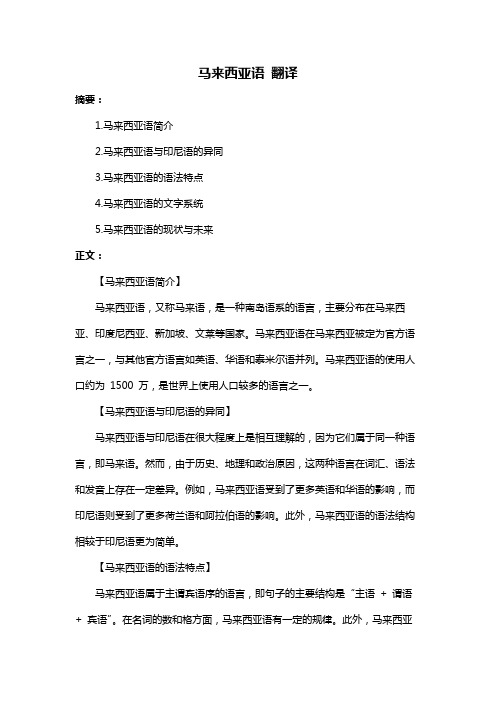
马来西亚语翻译摘要:1.马来西亚语简介2.马来西亚语与印尼语的异同3.马来西亚语的语法特点4.马来西亚语的文字系统5.马来西亚语的现状与未来正文:【马来西亚语简介】马来西亚语,又称马来语,是一种南岛语系的语言,主要分布在马来西亚、印度尼西亚、新加坡、文莱等国家。
马来西亚语在马来西亚被定为官方语言之一,与其他官方语言如英语、华语和泰米尔语并列。
马来西亚语的使用人口约为1500 万,是世界上使用人口较多的语言之一。
【马来西亚语与印尼语的异同】马来西亚语与印尼语在很大程度上是相互理解的,因为它们属于同一种语言,即马来语。
然而,由于历史、地理和政治原因,这两种语言在词汇、语法和发音上存在一定差异。
例如,马来西亚语受到了更多英语和华语的影响,而印尼语则受到了更多荷兰语和阿拉伯语的影响。
此外,马来西亚语的语法结构相较于印尼语更为简单。
【马来西亚语的语法特点】马来西亚语属于主谓宾语序的语言,即句子的主要结构是“主语+ 谓语+ 宾语”。
在名词的数和格方面,马来西亚语有一定的规律。
此外,马来西亚语的动词时态较为简单,主要分为现在时、过去时和将来时。
在句子中,动词通常放在句子的末尾。
【马来西亚语的文字系统】马来西亚语使用拉丁字母作为文字系统,共有26 个字母。
这些字母在马来西亚语中代表的是辅音和元音,而不是字母本身。
此外,马来西亚语还有一些特殊的字母和音调符号,用于表示特定的语音和语调。
【马来西亚语的现状与未来】随着马来西亚的国际地位不断提高,马来西亚语在国际间的影响力也在逐渐扩大。
如今,马来西亚语已成为一种重要的国际语言,被广泛应用于外交、商务和教育等领域。
马来语的语音特点对学习者有何影响
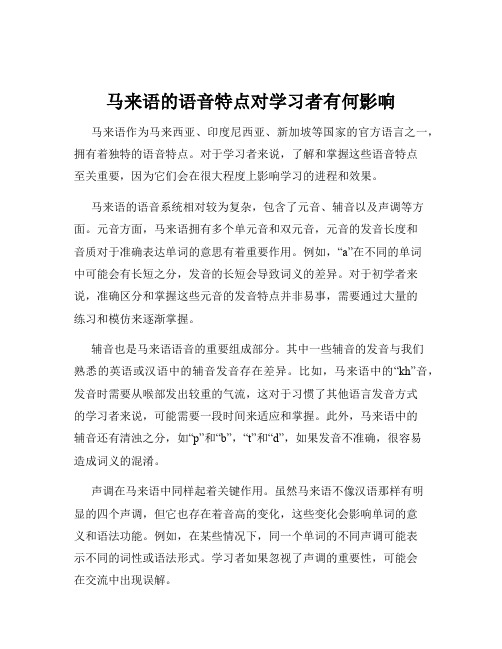
马来语的语音特点对学习者有何影响马来语作为马来西亚、印度尼西亚、新加坡等国家的官方语言之一,拥有着独特的语音特点。
对于学习者来说,了解和掌握这些语音特点至关重要,因为它们会在很大程度上影响学习的进程和效果。
马来语的语音系统相对较为复杂,包含了元音、辅音以及声调等方面。
元音方面,马来语拥有多个单元音和双元音,元音的发音长度和音质对于准确表达单词的意思有着重要作用。
例如,“a”在不同的单词中可能会有长短之分,发音的长短会导致词义的差异。
对于初学者来说,准确区分和掌握这些元音的发音特点并非易事,需要通过大量的练习和模仿来逐渐掌握。
辅音也是马来语语音的重要组成部分。
其中一些辅音的发音与我们熟悉的英语或汉语中的辅音发音存在差异。
比如,马来语中的“kh”音,发音时需要从喉部发出较重的气流,这对于习惯了其他语言发音方式的学习者来说,可能需要一段时间来适应和掌握。
此外,马来语中的辅音还有清浊之分,如“p”和“b”,“t”和“d”,如果发音不准确,很容易造成词义的混淆。
声调在马来语中同样起着关键作用。
虽然马来语不像汉语那样有明显的四个声调,但它也存在着音高的变化,这些变化会影响单词的意义和语法功能。
例如,在某些情况下,同一个单词的不同声调可能表示不同的词性或语法形式。
学习者如果忽视了声调的重要性,可能会在交流中出现误解。
马来语语音特点对学习者的影响首先体现在听力理解上。
由于马来语的语音具有一定的复杂性和特殊性,如果学习者没有掌握好其语音特点,在听力过程中就可能难以准确分辨单词和句子,从而影响对内容的理解。
特别是在快速的口语交流中,语音的连读、弱读等现象更加明显,这对于学习者的听力水平提出了更高的要求。
在口语表达方面,不准确的语音会导致交流障碍。
如果学习者的发音不符合马来语的标准,可能会让母语者难以理解,甚至产生误解。
而且,良好的语音能够增强语言的流利度和自然度,使交流更加顺畅和有效。
对于阅读和写作来说,虽然语音的影响相对较小,但正确的语音知识有助于学习者更好地记忆单词和拼写。
马来西亚文化和语言差异
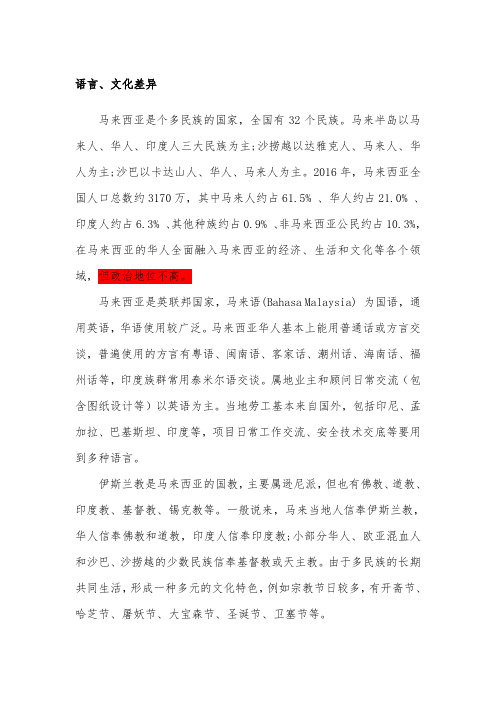
语言、文化差异马来西亚是个多民族的国家,全国有32个民族。
马来半岛以马来人、华人、印度人三大民族为主;沙捞越以达雅克人、马来人、华人为主;沙巴以卡达山人、华人、马来人为主。
2016年,马来西亚全国人口总数约3170万,其中马来人约占61.5% 、华人约占21.0% 、印度人约占6.3% 、其他种族约占0.9% 、非马来西亚公民约占10.3%,在马来西亚的华人全面融入马来西亚的经济、生活和文化等各个领域,但政治地位不高。
马来西亚是英联邦国家,马来语(Bahasa Malaysia) 为国语,通用英语,华语使用较广泛。
马来西亚华人基本上能用普通话或方言交谈,普遍使用的方言有粤语、闽南语、客家话、潮州话、海南话、福州话等,印度族群常用泰米尔语交谈。
属地业主和顾问日常交流(包含图纸设计等)以英语为主。
当地劳工基本来自国外,包括印尼、孟加拉、巴基斯坦、印度等,项目日常工作交流、安全技术交底等要用到多种语言。
伊斯兰教是马来西亚的国教,主要属逊尼派,但也有佛教、道教、印度教、基督教、锡克教等。
一般说来,马来当地人信奉伊斯兰教,华人信奉佛教和道教,印度人信奉印度教;小部分华人、欧亚混血人和沙巴、沙捞越的少数民族信奉基督教或天主教。
由于多民族的长期共同生活,形成一种多元的文化特色,例如宗教节日较多,有开斋节、哈芝节、屠妖节、大宝森节、圣诞节、卫塞节等。
政府规定的全国性节日主要有元旦、穆罕默德诞辰、春节(华人)、劳动节、卫塞节、最高元首诞辰、开斋节(穆斯林)、国庆日(又称独立日)、马来西亚日、哈芝节(穆斯林)、回历元旦、圣诞节,除少数日期固定外,其余的具体日期由政府在前一年统一公布,除全国性节日外,各州还有自己规定的节假日,属地普通管理人员假期基本必休,每年约有假期60天(包括周日),考虑周六不上班的员工,则每年约有假期90天。
工人基本为外籍劳工,假期上班则考虑加班费用。
马来人的习俗与中国相异处甚多,马来人普遍喜好辣食,忌食猪肉。
maylaisia的发音法
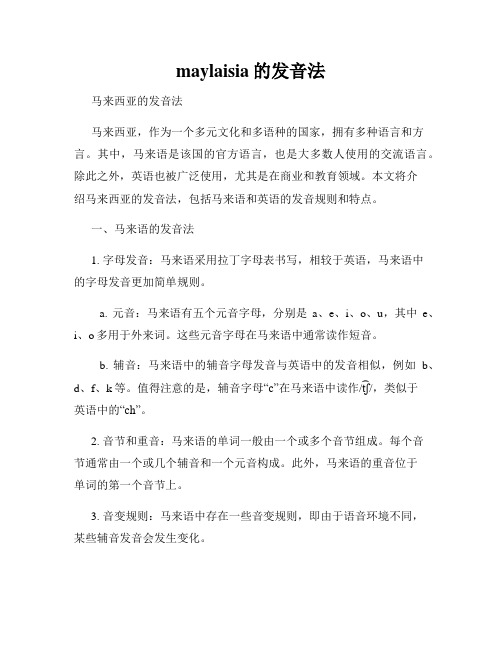
maylaisia的发音法马来西亚的发音法马来西亚,作为一个多元文化和多语种的国家,拥有多种语言和方言。
其中,马来语是该国的官方语言,也是大多数人使用的交流语言。
除此之外,英语也被广泛使用,尤其是在商业和教育领域。
本文将介绍马来西亚的发音法,包括马来语和英语的发音规则和特点。
一、马来语的发音法1. 字母发音:马来语采用拉丁字母表书写,相较于英语,马来语中的字母发音更加简单规则。
a. 元音:马来语有五个元音字母,分别是a、e、i、o、u,其中e、i、o多用于外来词。
这些元音字母在马来语中通常读作短音。
b. 辅音:马来语中的辅音字母发音与英语中的发音相似,例如b、d、f、k等。
值得注意的是,辅音字母“c”在马来语中读作/tʃ/,类似于英语中的“ch”。
2. 音节和重音:马来语的单词一般由一个或多个音节组成。
每个音节通常由一个或几个辅音和一个元音构成。
此外,马来语的重音位于单词的第一个音节上。
3. 音变规则:马来语中存在一些音变规则,即由于语音环境不同,某些辅音发音会发生变化。
a. 前鼻音化:当辅音/m/和/n/位于一个音节的词尾时,它们会前鼻音化,即变成鼻音/m/和/ñ/。
例如,“kampung”(乡村)读作[kampuŋ]。
b. 水声元音化:在一些方言中,辅音/p/和/t/会在元音/a/之前变成水声元音/ə/。
例如,“apa”(什么)读作[əpa]。
二、英语的发音法1. 字母发音:马来西亚的英语发音与国际音标发音规则相似。
下面是一些常见的英语字母发音规则:a. 元音:英语中有26个字母,其中有5个元音字母,分别是a、e、i、o、u。
这些元音字母的发音可以根据音标准确表示。
b. 辅音:英语中的辅音字母发音有一些变化规则,例如,辅音字母"c"在英语中可以读作/k/或/s/,具体发音取决于其后的元音字母。
另外,一些字母组合也有特定的发音规则,例如"th"读作/θ/或/ð/。
马来西亚华语特有词语探析
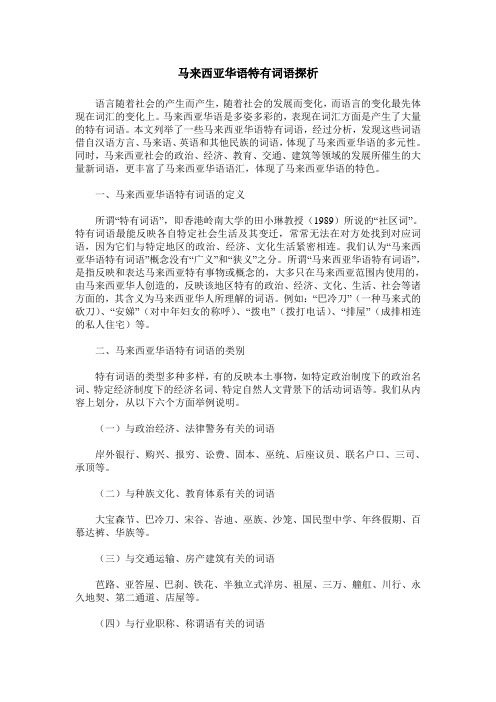
马来西亚华语特有词语探析语言随着社会的产生而产生,随着社会的发展而变化,而语言的变化最先体现在词汇的变化上。
马来西亚华语是多姿多彩的,表现在词汇方面是产生了大量的特有词语。
本文列举了一些马来西亚华语特有词语,经过分析,发现这些词语借自汉语方言、马来语、英语和其他民族的词语,体现了马来西亚华语的多元性。
同时,马来西亚社会的政治、经济、教育、交通、建筑等领域的发展所催生的大量新词语,更丰富了马来西亚华语语汇,体现了马来西亚华语的特色。
一、马来西亚华语特有词语的定义所谓“特有词语”,即香港岭南大学的田小琳教授(1989)所说的“社区词”。
特有词语最能反映各自特定社会生活及其变迁,常常无法在对方处找到对应词语,因为它们与特定地区的政治、经济、文化生活紧密相连。
我们认为“马来西亚华语特有词语”概念没有“广义”和“狭义”之分。
所谓“马来西亚华语特有词语”,是指反映和表达马来西亚特有事物或概念的,大多只在马来西亚范围内使用的,由马来西亚华人创造的,反映该地区特有的政治、经济、文化、生活、社会等诸方面的,其含义为马来西亚华人所理解的词语。
例如:“巴冷刀”(一种马来式的砍刀)、“安娣”(对中年妇女的称呼)、“拨电”(拨打电话)、“排屋”(成排相连的私人住宅)等。
二、马来西亚华语特有词语的类别特有词语的类型多种多样,有的反映本土事物,如特定政治制度下的政治名词、特定经济制度下的经济名词、特定自然人文背景下的活动词语等。
我们从内容上划分,从以下六个方面举例说明。
(一)与政治经济、法律警务有关的词语岸外银行、购兴、报穷、讼费、固本、巫统、后座议员、联名户口、三司、承顶等。
(二)与种族文化、教育体系有关的词语大宝森节、巴冷刀、宋谷、峇迪、巫族、沙笼、国民型中学、年终假期、百慕达裤、华族等。
(三)与交通运输、房产建筑有关的词语芭路、亚答屋、巴刹、铁花、半独立式洋房、祖屋、三万、艟舡、川行、永久地契、第二通道、店屋等。
(四)与行业职称、称谓语有关的词语拿督、峇峇、娘惹、阿窿王、海峡土生华人、安娣、敦、副姐、暗牌、峇峇、财副、钱币兑换商等。
马来语有什么特点
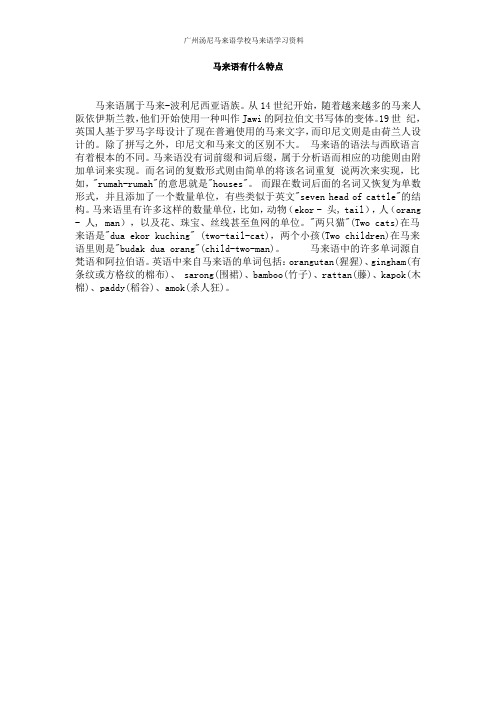
广州汤尼马来语学校马来语学习资料
马来语有什么特点
马来语属于马来-波利尼西亚语族。
从14世纪开始,随着越来越多的马来人阪依伊斯兰教,他们开始使用一种叫作Jawi的阿拉伯文书写体的变体。
19世纪,英国人基于罗马字母设计了现在普遍使用的马来文字,而印尼文则是由荷兰人设计的。
除了拼写之外,印尼文和马来文的区别不大。
马来语的语法与西欧语言有着根本的不同。
马来语没有词前缀和词后缀,属于分析语而相应的功能则由附加单词来实现。
而名词的复数形式则由简单的将该名词重复说两次来实现,比如,"rumah-rumah"的意思就是"houses"。
而跟在数词后面的名词又恢复为单数形式,并且添加了一个数量单位,有些类似于英文"seven head of cattle"的结构。
马来语里有许多这样的数量单位,比如,动物(ekor - 头, tail),人(orang - 人, man),以及花、珠宝、丝线甚至鱼网的单位。
"两只猫"(Two cats)在马来语是"dua ekor kuching" (two-tail-cat),两个小孩(Two children)在马来语里则是"budak dua orang"(child-two-man)。
马来语中的许多单词源自梵语和阿拉伯语。
英语中来自马来语的单词包括:orangutan(猩猩)、gingham(有条纹或方格纹的棉布)、 sarong(围裙)、bamboo(竹子)、rattan(藤)、kapok(木棉)、paddy(稻谷)、amok(杀人狂)。
马来语学习有哪些常见的挑战
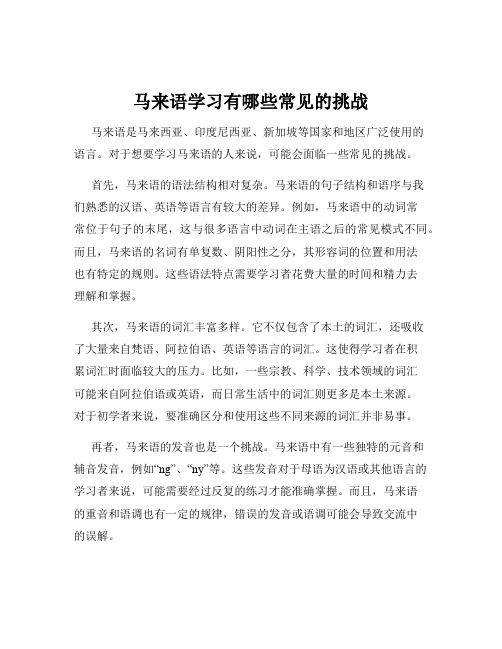
马来语学习有哪些常见的挑战马来语是马来西亚、印度尼西亚、新加坡等国家和地区广泛使用的语言。
对于想要学习马来语的人来说,可能会面临一些常见的挑战。
首先,马来语的语法结构相对复杂。
马来语的句子结构和语序与我们熟悉的汉语、英语等语言有较大的差异。
例如,马来语中的动词常常位于句子的末尾,这与很多语言中动词在主语之后的常见模式不同。
而且,马来语的名词有单复数、阴阳性之分,其形容词的位置和用法也有特定的规则。
这些语法特点需要学习者花费大量的时间和精力去理解和掌握。
其次,马来语的词汇丰富多样。
它不仅包含了本土的词汇,还吸收了大量来自梵语、阿拉伯语、英语等语言的词汇。
这使得学习者在积累词汇时面临较大的压力。
比如,一些宗教、科学、技术领域的词汇可能来自阿拉伯语或英语,而日常生活中的词汇则更多是本土来源。
对于初学者来说,要准确区分和使用这些不同来源的词汇并非易事。
再者,马来语的发音也是一个挑战。
马来语中有一些独特的元音和辅音发音,例如“ng”、“ny”等。
这些发音对于母语为汉语或其他语言的学习者来说,可能需要经过反复的练习才能准确掌握。
而且,马来语的重音和语调也有一定的规律,错误的发音或语调可能会导致交流中的误解。
另外,马来语的书写系统也可能给学习者带来困扰。
马来语使用拉丁字母书写,但其中一些字母的发音和用法与英语中的并不完全相同。
例如,字母“e”在马来语中的发音就有多种变化。
此外,马来语中还有一些特殊的标点符号和缩写形式,需要学习者专门去学习和记忆。
在语言学习的环境方面,缺乏真实的语言环境也是一个重要的挑战。
如果学习者身处非马来语国家或地区,很难有机会在日常生活中接触到地道的马来语交流。
没有足够的语言输入和实践机会,学习效果可能会大打折扣。
即使通过网络资源或语言课程学习,也难以完全替代真实的语言环境所带来的影响。
文化背景的差异也是学习马来语时不可忽视的挑战。
语言与文化紧密相连,马来语中很多词汇和表达方式都蕴含着特定的文化内涵。
马来西亚粤语广播的发展与受众特点分析

马来西亚粤语广播的发展与受众特点分析马来西亚是一个多民族国家,拥有多种语言和文化。
粤语是马来西亚华人社群中最为普遍使用的方言之一。
粤语广播在马来西亚有着广泛的发展与受众特点。
马来西亚的粤语广播历史可以追溯到上世纪50年代。
当时,马来西亚华人社群开始从事广播行业,并开办了多个粤语广播电台,如马来西亚《南洋商报》的新加坡消声广播和吉隆坡消声电台等。
这些广播电台主要面向华人社群,以粤语为主要播音语言,涵盖新闻、时事、娱乐、音乐等内容。
随着科技的进步和多媒体的发展,粤语广播形式也逐渐多样化。
在传统广播的基础上,马来西亚的粤语广播开始利用互联网、手机应用等新媒体平台传播内容。
这不仅提高了广播的覆盖率和传播效果,也为受众提供了更加便利的收听方式。
马来西亚粤语广播的受众主要集中于华人社群。
马来西亚有着庞大的华人人口,他们大多是使用粤语的方言群体。
这些华人群体希望能够通过广播了解最新的新闻和时事动态,同时也希望能够收听到粤语歌曲和其他娱乐节目。
马来西亚粤语广播的受众还包括一些对粤语有兴趣的其他族群,如部分马来人、印度人等。
这些人群可能在学校或工作中接触到粤语,并对其产生了兴趣。
由于马来西亚的多元文化背景,一些华人家庭也会选择让他们的孩子在家中学习粤语,因此他们也成为了粤语广播的潜在受众。
马来西亚粤语广播的受众特点在于他们对本土化内容的需求。
马来西亚的华人社群希望广播能够关注当地的新闻、社区活动、文化活动等,以满足他们的需求。
他们也对粤语电台中播放的华语和粤语歌曲、综艺节目、电视剧等感兴趣,希望能够通过广播了解这些内容。
马来西亚粤语广播在马来西亚华人社群中有着广泛的发展与受众特点。
在广播内容上,除了提供最新的新闻和时事动态外,马来西亚粤语广播还注重本土化和娱乐化,以满足受众的需求。
随着科技的进步和多媒体的发展,粤语广播也在不断创新与进化,为受众提供更多样化的收听方式。
马来西亚语言的“马赛克现象”
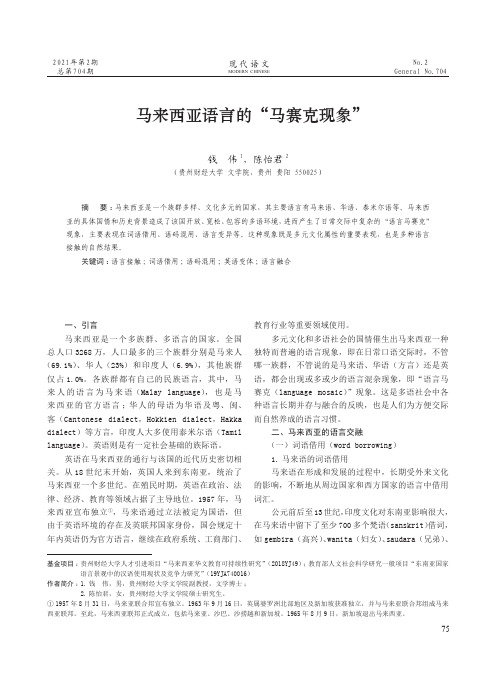
75基金项目:贵州财经大学人才引进项目“马来西亚华文教育可持续性研究”(2018YJ49);教育部人文社会科学研究一般项目“东南亚国家语言景观中的汉语使用现状及竞争力研究”(19YJA740016)作者简介:1.钱 伟,男,贵州财经大学文学院副教授,文学博士;2.陈怡君,女,贵州财经大学文学院硕士研究生。
①1957年8月31日,马来亚联合邦宣布独立。
1963年9月16日,英属婆罗洲北部地区及新加坡获准独立,并与马来亚联合邦组成马来西亚联邦。
至此,马来西亚联邦正式成立,包括马来亚、沙巴、沙捞越和新加坡。
1965年8月9日,新加坡退出马来西亚。
马来西亚语言的“马赛克现象”钱 伟1,陈怡君2(贵州财经大学 文学院,贵州 贵阳 550025)摘 要:马来西亚是一个族群多样、文化多元的国家,其主要语言有马来语、华语、泰米尔语等。
马来西亚的具体国情和历史背景造成了该国开放、宽松、包容的多语环境,进而产生了日常交际中复杂的“语言马赛克”现象,主要表现在词语借用、语码混用、语言变异等。
这种现象既是多元文化属性的重要表现,也是多种语言接触的自然结果。
关键词:语言接触;词语借用;语码混用;英语变体;语言融合2021年第2期总第704期MODERN CHINESE No.2General No.704现代语文一、引言马来西亚是一个多族群、多语言的国家。
全国总人口3268万,人口最多的三个族群分别是马来人(69.1%)、华人(23%)和印度人(6.9%),其他族群仅占1.0%。
各族群都有自己的民族语言,其中,马来人的语言为马来语(Malay language),也是马来西亚的官方语言;华人的母语为华语及粤、闽、客(Cantonese dialect,Hokkien dialect,Hakka dialect)等方言,印度人大多使用泰米尔语(Tamillanguage)。
英语则是有一定社会基础的族际语。
英语在马来西亚的通行与该国的近代历史密切相关。
马来西亚粤语广播的发展与受众特点分析
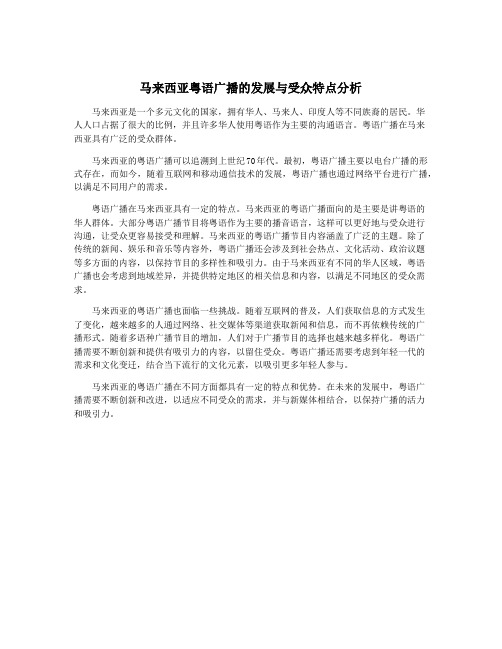
马来西亚粤语广播的发展与受众特点分析马来西亚是一个多元文化的国家,拥有华人、马来人、印度人等不同族裔的居民。
华人人口占据了很大的比例,并且许多华人使用粤语作为主要的沟通语言。
粤语广播在马来西亚具有广泛的受众群体。
马来西亚的粤语广播可以追溯到上世纪70年代。
最初,粤语广播主要以电台广播的形式存在,而如今,随着互联网和移动通信技术的发展,粤语广播也通过网络平台进行广播,以满足不同用户的需求。
粤语广播在马来西亚具有一定的特点。
马来西亚的粤语广播面向的是主要是讲粤语的华人群体。
大部分粤语广播节目将粤语作为主要的播音语言,这样可以更好地与受众进行沟通,让受众更容易接受和理解。
马来西亚的粤语广播节目内容涵盖了广泛的主题。
除了传统的新闻、娱乐和音乐等内容外,粤语广播还会涉及到社会热点、文化活动、政治议题等多方面的内容,以保持节目的多样性和吸引力。
由于马来西亚有不同的华人区域,粤语广播也会考虑到地域差异,并提供特定地区的相关信息和内容,以满足不同地区的受众需求。
马来西亚的粤语广播也面临一些挑战。
随着互联网的普及,人们获取信息的方式发生了变化,越来越多的人通过网络、社交媒体等渠道获取新闻和信息,而不再依赖传统的广播形式。
随着多语种广播节目的增加,人们对于广播节目的选择也越来越多样化。
粤语广播需要不断创新和提供有吸引力的内容,以留住受众。
粤语广播还需要考虑到年轻一代的需求和文化变迁,结合当下流行的文化元素,以吸引更多年轻人参与。
马来西亚的粤语广播在不同方面都具有一定的特点和优势。
在未来的发展中,粤语广播需要不断创新和改进,以适应不同受众的需求,并与新媒体相结合,以保持广播的活力和吸引力。
马来语的语音系统有何特点
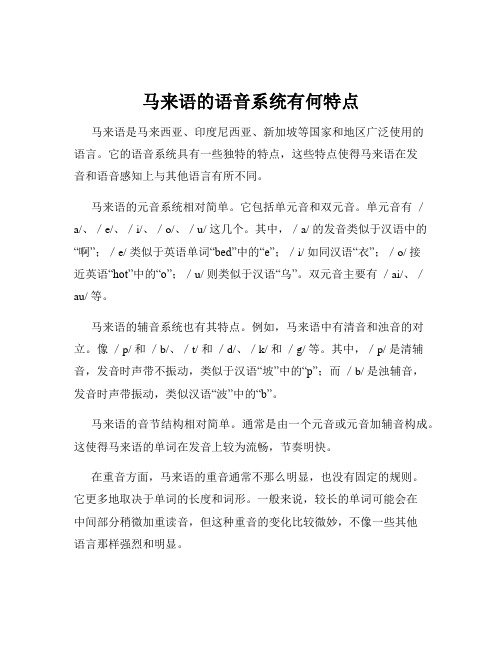
马来语的语音系统有何特点马来语是马来西亚、印度尼西亚、新加坡等国家和地区广泛使用的语言。
它的语音系统具有一些独特的特点,这些特点使得马来语在发音和语音感知上与其他语言有所不同。
马来语的元音系统相对简单。
它包括单元音和双元音。
单元音有/a/、/e/、/i/、/o/、/u/ 这几个。
其中,/a/ 的发音类似于汉语中的“啊”;/e/ 类似于英语单词“bed”中的“e”;/i/ 如同汉语“衣”;/o/ 接近英语“hot”中的“o”;/u/ 则类似于汉语“乌”。
双元音主要有/ai/、/au/ 等。
马来语的辅音系统也有其特点。
例如,马来语中有清音和浊音的对立。
像/p/ 和/b/、/t/ 和/d/、/k/ 和/g/ 等。
其中,/p/ 是清辅音,发音时声带不振动,类似于汉语“坡”中的“p”;而/b/ 是浊辅音,发音时声带振动,类似汉语“波”中的“b”。
马来语的音节结构相对简单。
通常是由一个元音或元音加辅音构成。
这使得马来语的单词在发音上较为流畅,节奏明快。
在重音方面,马来语的重音通常不那么明显,也没有固定的规则。
它更多地取决于单词的长度和词形。
一般来说,较长的单词可能会在中间部分稍微加重读音,但这种重音的变化比较微妙,不像一些其他语言那样强烈和明显。
马来语的语音还有连读的特点。
在句子中,相邻的单词之间发音往往会相互影响,连读使得语言的表达更加自然和流畅。
例如,“saya pergi ke sekolah”(我去学校),“pergi”(去)的尾音和“ke”(到)的开头音会连读。
另外,马来语的语音在语调上也有特点。
它的语调相对平稳,没有太大的起伏。
但在表达疑问、强调等语气时,语调会有一定的变化。
马来语的语音系统还受到其语言环境和文化背景的影响。
例如,在马来文化中,人们在交流时注重语气的温和与尊重,这也在一定程度上反映在语音的表达方式上。
对于学习马来语的人来说,了解其语音系统的特点是非常重要的。
只有掌握了正确的发音,才能更好地理解和表达这门语言,与使用马来语的人们进行有效的交流。
马来西亚英语口头禅
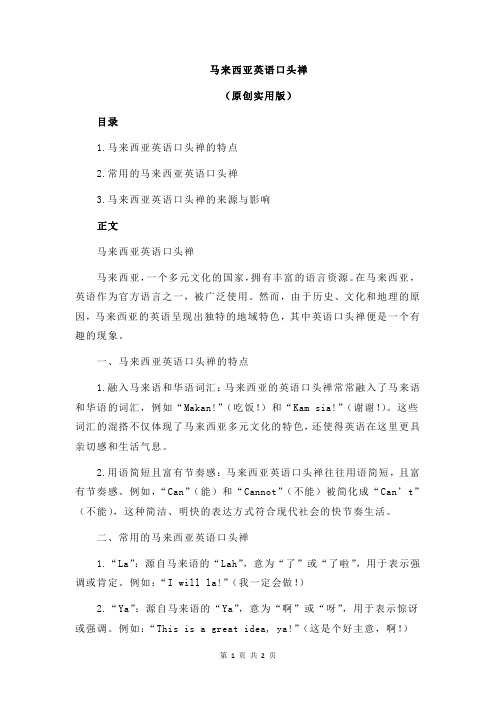
马来西亚英语口头禅(原创实用版)目录1.马来西亚英语口头禅的特点2.常用的马来西亚英语口头禅3.马来西亚英语口头禅的来源与影响正文马来西亚英语口头禅马来西亚,一个多元文化的国家,拥有丰富的语言资源。
在马来西亚,英语作为官方语言之一,被广泛使用。
然而,由于历史、文化和地理的原因,马来西亚的英语呈现出独特的地域特色,其中英语口头禅便是一个有趣的现象。
一、马来西亚英语口头禅的特点1.融入马来语和华语词汇:马来西亚的英语口头禅常常融入了马来语和华语的词汇,例如“Makan!”(吃饭!)和“Kam sia!”(谢谢!)。
这些词汇的混搭不仅体现了马来西亚多元文化的特色,还使得英语在这里更具亲切感和生活气息。
2.用语简短且富有节奏感:马来西亚英语口头禅往往用语简短,且富有节奏感。
例如,“Can”(能)和“Cannot”(不能)被简化成“Can’t”(不能),这种简洁、明快的表达方式符合现代社会的快节奏生活。
二、常用的马来西亚英语口头禅1.“La”:源自马来语的“Lah”,意为“了”或“了啦”,用于表示强调或肯定。
例如:“I will la!”(我一定会做!)2.“Ya”:源自马来语的“Ya”,意为“啊”或“呀”,用于表示惊讶或强调。
例如:“This is a great idea, ya!”(这是个好主意,啊!)3.“Makan”:源自马来语,意为“吃饭”。
例如:“Let’s go makan!”(我们去吃饭吧!)4.“Kam sia”:源自华语,意为“谢谢”。
例如:“Thank you, kam sia!”(谢谢,谢谢!)三、马来西亚英语口头禅的来源与影响1.历史原因:马来西亚英语口头禅的形成与历史密切相关。
自 19 世纪以来,马来西亚便受到英国殖民统治,英语成为官方语言。
然而,由于马来语、华语等其他语言的影响,英语在这里逐渐演变成具有地域特色的英语。
2.文化交融:马来西亚是一个多元文化的国家,拥有马来人、华人、印度人等多个民族。
马来西亚英语口头禅
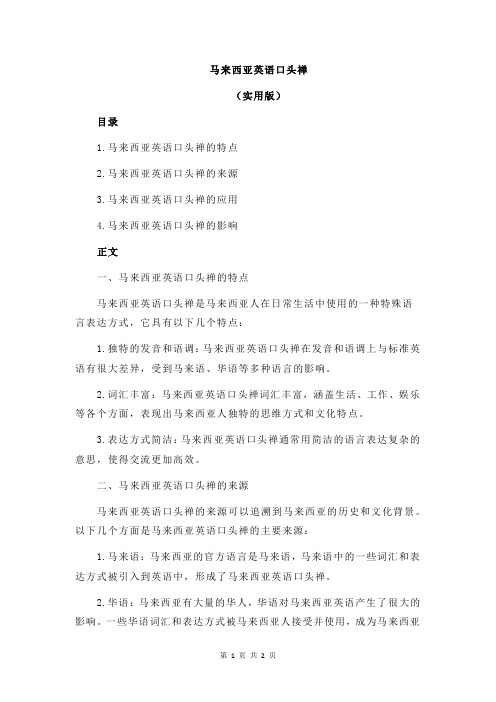
马来西亚英语口头禅(实用版)目录1.马来西亚英语口头禅的特点2.马来西亚英语口头禅的来源3.马来西亚英语口头禅的应用4.马来西亚英语口头禅的影响正文一、马来西亚英语口头禅的特点马来西亚英语口头禅是马来西亚人在日常生活中使用的一种特殊语言表达方式,它具有以下几个特点:1.独特的发音和语调:马来西亚英语口头禅在发音和语调上与标准英语有很大差异,受到马来语、华语等多种语言的影响。
2.词汇丰富:马来西亚英语口头禅词汇丰富,涵盖生活、工作、娱乐等各个方面,表现出马来西亚人独特的思维方式和文化特点。
3.表达方式简洁:马来西亚英语口头禅通常用简洁的语言表达复杂的意思,使得交流更加高效。
二、马来西亚英语口头禅的来源马来西亚英语口头禅的来源可以追溯到马来西亚的历史和文化背景。
以下几个方面是马来西亚英语口头禅的主要来源:1.马来语:马来西亚的官方语言是马来语,马来语中的一些词汇和表达方式被引入到英语中,形成了马来西亚英语口头禅。
2.华语:马来西亚有大量的华人,华语对马来西亚英语产生了很大的影响。
一些华语词汇和表达方式被马来西亚人接受并使用,成为马来西亚英语口头禅的一部分。
3.英国殖民地历史:马来西亚曾是英国的殖民地,英语成为马来西亚人的第二语言。
在长期的殖民地历史中,马来西亚人接触到英国的英语文化,并将其融入到自己的语言表达中。
三、马来西亚英语口头禅的应用马来西亚英语口头禅在日常生活、工作和娱乐等各个领域都有广泛应用,以下是一些典型的例子:1.日常生活:在日常交流中,马来西亚人常用英语口头禅表达自己的情感和观点,如“啦”、“嘛”等。
2.工作场合:在工作场合,马来西亚人会使用一些表达方式简洁的英语口头禅,以提高工作效率,如“OK 啦”、“搞定”等。
3.娱乐活动:在娱乐活动中,马来西亚人喜欢用英语口头禅表达自己的情感,如在看电影或比赛时,会说“好帅哦”、“好棒”等。
四、马来西亚英语口头禅的影响马来西亚英语口头禅对马来西亚的社会和文化产生了一定的影响,具体表现在以下几个方面:1.促进文化交流:马来西亚英语口头禅作为一种独特的语言现象,有助于增进马来西亚人与其他国家人民的文化交流和理解。
马来语的书面形式与口语有何差异
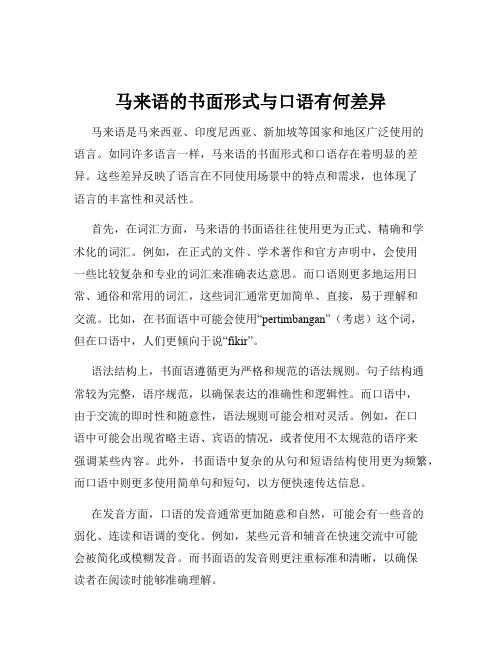
马来语的书面形式与口语有何差异马来语是马来西亚、印度尼西亚、新加坡等国家和地区广泛使用的语言。
如同许多语言一样,马来语的书面形式和口语存在着明显的差异。
这些差异反映了语言在不同使用场景中的特点和需求,也体现了语言的丰富性和灵活性。
首先,在词汇方面,马来语的书面语往往使用更为正式、精确和学术化的词汇。
例如,在正式的文件、学术著作和官方声明中,会使用一些比较复杂和专业的词汇来准确表达意思。
而口语则更多地运用日常、通俗和常用的词汇,这些词汇通常更加简单、直接,易于理解和交流。
比如,在书面语中可能会使用“pertimbangan”(考虑)这个词,但在口语中,人们更倾向于说“fikir”。
语法结构上,书面语遵循更为严格和规范的语法规则。
句子结构通常较为完整,语序规范,以确保表达的准确性和逻辑性。
而口语中,由于交流的即时性和随意性,语法规则可能会相对灵活。
例如,在口语中可能会出现省略主语、宾语的情况,或者使用不太规范的语序来强调某些内容。
此外,书面语中复杂的从句和短语结构使用更为频繁,而口语中则更多使用简单句和短句,以方便快速传达信息。
在发音方面,口语的发音通常更加随意和自然,可能会有一些音的弱化、连读和语调的变化。
例如,某些元音和辅音在快速交流中可能会被简化或模糊发音。
而书面语的发音则更注重标准和清晰,以确保读者在阅读时能够准确理解。
表达方式上也存在显著差异。
书面语更注重语言的规范性、准确性和严谨性,常常使用正式的、客观的表达方式,避免使用过于随意或情感化的语言。
相比之下,口语更加生动、活泼,允许使用更多的感叹词、俗语、俚语和流行语,以增强交流的情感色彩和趣味性。
比如,在口语中,人们可能会说“Alamak!”(哎呀!)来表达惊讶,但在书面语中这种表达方式就不太合适。
再者,从使用场景来看,书面语主要用于正式的场合,如政府文件、法律条文、学术研究、新闻报道等。
这些场合要求语言准确、清晰、规范,以传达重要的信息和知识。
马来语的方言差异对学习者有何影响
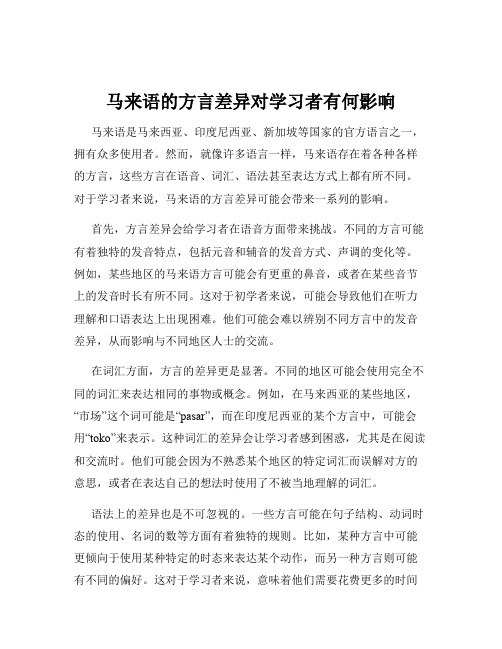
马来语的方言差异对学习者有何影响马来语是马来西亚、印度尼西亚、新加坡等国家的官方语言之一,拥有众多使用者。
然而,就像许多语言一样,马来语存在着各种各样的方言,这些方言在语音、词汇、语法甚至表达方式上都有所不同。
对于学习者来说,马来语的方言差异可能会带来一系列的影响。
首先,方言差异会给学习者在语音方面带来挑战。
不同的方言可能有着独特的发音特点,包括元音和辅音的发音方式、声调的变化等。
例如,某些地区的马来语方言可能会有更重的鼻音,或者在某些音节上的发音时长有所不同。
这对于初学者来说,可能会导致他们在听力理解和口语表达上出现困难。
他们可能会难以辨别不同方言中的发音差异,从而影响与不同地区人士的交流。
在词汇方面,方言的差异更是显著。
不同的地区可能会使用完全不同的词汇来表达相同的事物或概念。
例如,在马来西亚的某些地区,“市场”这个词可能是“pasar”,而在印度尼西亚的某个方言中,可能会用“toko”来表示。
这种词汇的差异会让学习者感到困惑,尤其是在阅读和交流时。
他们可能会因为不熟悉某个地区的特定词汇而误解对方的意思,或者在表达自己的想法时使用了不被当地理解的词汇。
语法上的差异也是不可忽视的。
一些方言可能在句子结构、动词时态的使用、名词的数等方面有着独特的规则。
比如,某种方言中可能更倾向于使用某种特定的时态来表达某个动作,而另一种方言则可能有不同的偏好。
这对于学习者来说,意味着他们需要花费更多的时间和精力来掌握不同的语法规则,否则可能会在语法使用上出现错误,影响语言表达的准确性。
方言差异还可能影响学习者对语言文化的理解。
语言不仅仅是交流的工具,更是文化的载体。
不同的方言往往反映了当地的文化特色、生活方式和价值观念。
如果学习者只了解一种方言,可能会对马来语所承载的丰富文化内涵理解得不够全面。
例如,某些方言中的特定词汇或表达方式可能与当地的传统习俗、宗教信仰等密切相关,不了解这些差异,就难以真正领略马来语文化的魅力。
马来西亚语翻译
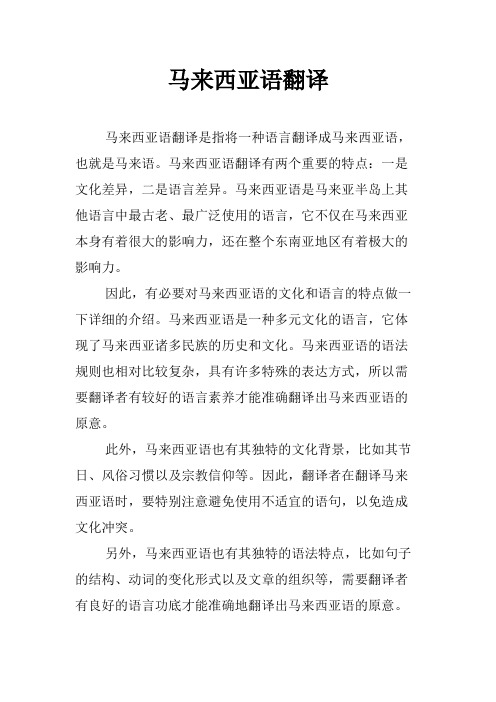
马来西亚语翻译
马来西亚语翻译是指将一种语言翻译成马来西亚语,也就是马来语。
马来西亚语翻译有两个重要的特点:一是文化差异,二是语言差异。
马来西亚语是马来亚半岛上其他语言中最古老、最广泛使用的语言,它不仅在马来西亚本身有着很大的影响力,还在整个东南亚地区有着极大的影响力。
因此,有必要对马来西亚语的文化和语言的特点做一下详细的介绍。
马来西亚语是一种多元文化的语言,它体现了马来西亚诸多民族的历史和文化。
马来西亚语的语法规则也相对比较复杂,具有许多特殊的表达方式,所以需要翻译者有较好的语言素养才能准确翻译出马来西亚语的原意。
此外,马来西亚语也有其独特的文化背景,比如其节日、风俗习惯以及宗教信仰等。
因此,翻译者在翻译马来西亚语时,要特别注意避免使用不适宜的语句,以免造成文化冲突。
另外,马来西亚语也有其独特的语法特点,比如句子的结构、动词的变化形式以及文章的组织等,需要翻译者有良好的语言功底才能准确地翻译出马来西亚语的原意。
总之,翻译马来西亚语时,不仅要注意文化和语言的差异,还要掌握马来西亚语的文化背景、语法特点,以及掌握一定的文字表达技巧,才能准确无误地将外语翻译成马来西亚语。
- 1、下载文档前请自行甄别文档内容的完整性,平台不提供额外的编辑、内容补充、找答案等附加服务。
- 2、"仅部分预览"的文档,不可在线预览部分如存在完整性等问题,可反馈申请退款(可完整预览的文档不适用该条件!)。
- 3、如文档侵犯您的权益,请联系客服反馈,我们会尽快为您处理(人工客服工作时间:9:00-18:30)。
speak”, 后面加上了英语后缀“ - ster”构成 。 一些英语词汇或短语在马来式英语中的意思与其在英
国英语中的意思有所不同 。例如 :
20) “send”在 马 来 式 英 语 中 意 为 : to take so meo ne
so mewhere Can yo u send me to t he airpo rt ? 意指 Can yo u drive me
to t he airport ? 21) “follow”在马来式英语中意为 :to acco mpany Can I follow yo u ? 意指 Can I co me wit h yo u ? 马来式英语还创造了一些自己独有的词汇 ,即这些词
汇只在马来式英语中存在 。例如 : 22) handp ho ne 意指 mo bile p ho ne or cell p ho ne 手机 23) o ut statio n 意指 at work o ut of town 出差在外 24) Photo stat 意指 p hotocop y 影印 25) airco n 意指 air - co nditio ner 空调机 (郭熙 ,2005 :87 - 94)
语
同地方的各种方言带到了这里 。由于华语并非官方语言 ,
言
亦非通用语言 ,而仅仅是华族的民族语言 ,属弱势语种 。在
特
马来西亚政府采取措施推广和提升马来语作为国语的地位
点
的过程中 ,马来西亚华人群体为母语华语的传承进行了长
期不懈的努力 。
华语 ,即汉语普通话 ,是马来西亚华人之间进行交流的 主要语言 。此外 ,马来西亚华人同时也使用其他一些汉语
四 、马来西亚华语的特点
语 言 学
柯 永 红
自从 15 世纪初中国商人来到马来西亚 ,华人就在这片
论
土地上扎下根来 ,为它的繁荣和兴旺做出了卓越的贡献 。 马
目前 ,马来西亚华人占马来西亚人口总数的 26 % ,成为马 来西亚主要的民族之一 。马来西亚华人的祖先多来自中国
来 西 亚
大陆沿海一带的广东 、福建 、海南以及台湾等地 ,他们把不
三 、马来西亚英语的特点
由于英国对马来西亚实行了为期较长的殖民统治 ,英 国语言文化不可避免地渗透到了这片土地 ,对马来西亚语 言文化的发展起到了极其深刻的影响 。英语语言的词汇和 表达被马来西亚各族语言所借用 。而英语本身也反过来受 到马来西亚本土各族语言的影响 ,在用词 、造句上都发生了 一些变化 , 从而形成了具有马来西亚特点的马来式 英 语 ( Manglish) 。
当地华语的影响最大 。华语表达中掺杂有广东话 、闽南话
等地方方言的词汇 ,形成了与中国本土标准普通话有所不 同的特点 。例如 :
26) 中国人 : 今晚你有空吗 ? 我没空 !
马来西亚华人 : 今晚你得不得空 ? 我不得空 (广东话 的词汇)
27) 中国人 : 你很强~
马来西亚华人 :你很够力~ (广东话的词汇) 28) 中国人 : 明天也叫他一起去吧 !
尽管马来语是国语和官方语言 ,马来西亚多民族文化 相互渗透 ,使马来语在发展过程中免不了接纳了一些外来 语 ,产生了一些新的词汇 。这些新词的构成方式是根据外 来词的读音进行转写而成 。在一些马来语词汇中我们可以 清楚地看到一些英语词汇的影子 。例如 :
1) 海关 : 马来语“kastam”, 英语“custo ms” 2) 坐垫 : 马来语“kusyen”, 英语“cushio n” 3) 警察 : 马来语“polis”, 英语“police” 4) 政治 : 马来语“politik”, 英语“politics” 5) 校园 : 马来语“kamp us”, 英语“camp us” 马来语里还有不少词汇来源于汉语方言闽南话 。例 如: 6) 小姐 : 马来语“siociah”, 闽南话“小姐” 7) 老大爷 : 马来语“apek”, 闽南话“阿伯” 8) 楼上 : 马来语“loteng”, 闽南话“楼顶” 9) 茶壶 : 马来语“teko”, 闽南话“茶钴” 10) 韭菜 : 马来语“kucai”, 闽南话“韭菜” (陈晓锦 ,2003 :244~310 ;郭熙 ,2005 :87~94) 马来语的这 些 特 点 正 是 马 来 西 亚 各 民 族 文 化 相 互 融 合 、渗透的产物 。而这种文化的相互融合和渗透不仅仅表
地方方言 ,如广东话 、闽南话 、客家话 、潮州话 、海南话等 。 马来西亚华人一般都能说华语和一到两种 ,甚至两种以上 的汉语方言 。马来西亚华族之间说话方式往往混杂了几种
当地语言 :华语 、中国南方沿海一带的各种汉语方言 、英语 和马来语在同一时间一起使用 。在这种多语言交织的背景
下 ,马来西亚华语受到不同地方方言的影响 ,以广东话给予
在马来式英语中 ,许多马来语的词汇被借用到英语的 表达中来 。此外 ,普通话 、广东话以及泰米尔语的一些词汇 也被用作为马来式英语中的常用词 。例如 :
11) 后缀“lah”的使用 。源自广东话的表达语“啦”,表 示肯定某种说法 。在马来式英语中 ,通常被用在句末 ,并于 感叹号“ !”连用 :
Do n’t be so worried - lah ! 12) 语气词“nah”的使用 。源自汉语的表达习惯 。通 常在以粗鲁或不耐烦的方式把东西给别人时使用 : Nah , take t his ! 13) 后缀“liao”的使用 。源自汉语的“了”, 表示“已 经”的含义 : No stock liao . 14) 后缀“lor”的使用 。源自广东话的表达语的“啰”, 表示说明某事物 : Like t hat lo r ! 15) 词汇“got”是把马来语中“ada”一词照字面翻译 过来使用的 ,用以表达英语中“to have”的各种时态的用法 : I got already/ got my car f ro m t he garage. Got questio n ? ( Is t here a questio n ? / Do yo u have a questio n ? 16) “makan”在马来语中是“吃”的意思 ,通常指吃午饭 或吃晚饭 。该词被直接用到英语的表达中来 : Yo u makan dy ? ( Have yo u taken yo ur dinner/ lunch ?) 17) “what”在马来式英语中并非等同其原意 ,它被当 做感叹号来用 ,而非用作疑问词 : What ! How co uld yo u do t hat ? I didn’t take it what . 马来式英语的另一个特点是 ,源自于其他语言的一些 动词或形容词加上了英语的词缀 ,或在另一种语言的句子 结构的基础上使用英语词汇来造句 。人们往往将一些惯用 语从他们的母语直译成英语 ,例如 : 18) “o n t he light”instead of“t urn o n t he light”. 有时 说成 ,“open t he light”,这种表达是从汉语直译过来的 。同 样还有“Do n’t forget to off t he fan. ”
米尔语 ,还有泰卢固语 、马拉亚拉姆语和旁遮普语 。泰语也
是马来西亚的地方语种之一 伊班语 ( Iban) 和卡达占语 ( Kadazan) 。
在马来西亚 ,多语言并存的环境使得语言使用者之间 至少通用两门语言 —马来语和英语 。因此 ,人们在进行交
© 1994-2010 China Academic Journal Electronic Publishing House. All rights reserved.
现在马来语里 ,在马来西亚使用的其他语言中均能反映出 来 。马来西亚各种语言对外来词语的借用不仅丰富了各语 言本身 ,也使马来西亚各民族间的语言交流具有相互交织 、 多语言一同并用的特点 。
柯 永 红 论 马 来 西 亚 语 言 特 点
1 14
[ 摘 要 ] 对马来西亚的语言特点进行分析和归纳 ,以增进对马来西亚民族语文的了解 。认为马来 西亚多民族 、多文化 、多宗教的特点决定了马来西亚语言上的多样化 。马来西亚多语言并存的环境使得 语言使用者之间至少通用两门语言 。因此 ,人们在进行交谈时会出现语言交错的现象 。人们可以用两种 或者两种以上绝然不同的语言相互交谈 。
自从英国完成对马来西亚的殖民地统治直到马来西亚 独立后的前十年 ,英语一直是马来西亚的官方语言 。独立 后 ,在多语并存的情况下 ,为了确立和突出马来语作为官方 语言的地位 ,马来西亚政府采取了一系列强制性的规定和 措施 。一方面规定各民族语文的牌匾用字 ,尺寸上不得大 于马来文 。而相关机构也规定国家电台 、电视台华语广播 中涉及非华族人名 、当地地名 ,要采用马来语的读法等 (郭 熙 ,2005 :87~94) 。另一方面政府规定从小学到大学都必 须以马来语为教学媒介语 。马来西亚政府通过采取这些措 施使马来语得到快速推广 ,马来语的地位也得以迅速提高 。
[ 关键词 ] 马来西亚 ;语言 ;特点 [ 中图分类号 ] H6311 1 [ 文献标识码 ] A [ 文章编号 ] 1673 - 8179 (2009) J Z01 - 0114 - 03
一 、引言
马
来西亚是一个多民族 、多文化 、多宗教的国家 。马 来族 、华族和印度族是马来西亚三大主要民族 。根 据 2000 年的人口普查结果表明 ,马来西亚大部分
人信奉伊斯兰教 ,占总人口的 60 . 4 % ;其次是信奉佛教 ,占
19. 2 % ;另有 9 . 1 %信奉基督教 ;6. 3 %信奉印度教 ;3 %信奉 道教及其他中国传统宗教 。各民族都有自己独特的文化 。
马来西亚多民族 、多文化的社会特点决定了马来西亚语言
上的多样化 。在马来西亚使用的语言主要有马来语 、华语 、
19) “kap ster”意思是“a no sy or talkative per so n”。它 也可用作形容词 ,如 “ : I hate t hem because t hey are so kap2
